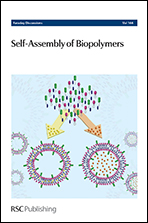Block copolymers in giant unilamellar vesicles with proteins or with phospholipids
Abstract
Biocompatible, highly water-soluble, nonionic, amphiphilic block copolymers having different hydrophobic blocks and architectures, but similar molecular size and chemical nature of the hydrophilic blocks, were investigated to check for their ability to form hybrid giant unilamellar vesicles with proteins, and for their interactions with giant unilamellar phospholipid vesicles (GUV). PGM14-b-PPO34-b-PGM14 (PGM-PPO-PGM) consists of a poly(propylene oxide) middle block and outer poly(glycerol monomethacrylate) blocks. Ch-PEG32-b-lPG18 (Ch-PEG-lPG) and Ch-PEG30-b-hbPG17 (Ch-PEG-hbPG) have a linear poly(ethylene glycol) block, linked to a cholesterol end group and to a linear (lPG) or hyperbranched (hbPG) polyglycerol block. Fluorescently-labelled polymers were synthesised to image and analyse the self-assembling and interaction processes using confocal laser scanning microscopy (CLSM). By implementing a novel strategy for polymersomes formation the copolymers were found to spontaneously form giant unilamellar vesicles with proteins in aqueous solution. Furthermore, the investigation of the interaction of the block copolymers with different phospholipid GUVs provided detailed information about the structure–behaviour relationship. Additionally, it was found that these neutral copolymers are able to cross artificial and natural phospholipid membranes.
- This article is part of the themed collection: Self-Assembly of Biopolymers

 Please wait while we load your content...
Please wait while we load your content...